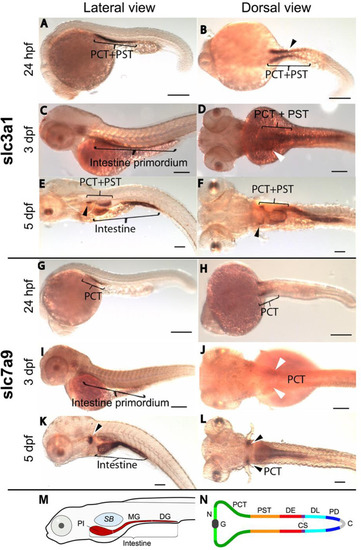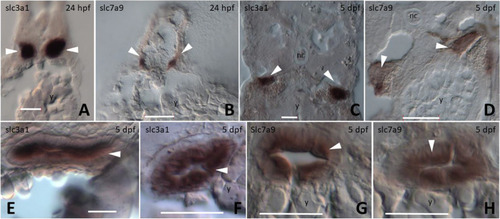- Title
-
The zebrafish cationic amino acid transporter/glycoprotein-associated family: sequence and spatiotemporal distribution during development of the transport system b0,+ (slc3a1/slc7a9)
- Authors
- Ellingsen, S., Narawane, S., Fjose, A., Verri, T., Rønnestad, I.
- Source
- Full text @ Fish Physiol. Biochem.
|
(A) Three-dimensional appearance (lateral view) of the zebrafish Slc7a9(b0,+AT)-Slc3a1(rBAT) complex bound to arginine in the hetero-2–2-mer (i.e., heterotetramer made of 2 heterodimers) form and (B) snapshot of the putative disulfide bridge linking covalently one of the two heterodimers (i.e., the heterodimer made of chain C, Slc3a1 and chain D, Slc7a9). The model was built using Protein Data Bank Acc. No. 6li9.1 as a template. Cysteine residues only are highlighted (yellow). A, chain A; B, chain B; C, chain C; D, chain D. Chains A and C refer to zebrafish Slc3a1; chains B and D refer to zebrafish Slc7a9. C104, cysteine residue C104 on chain C, Slc3a1; C150, cysteine residue C150 on chain D, Slc7a9 |
|
Evolutionary relationships of taxa for Slc3a1 and Slc7a9. The evolutionary history was inferred using the Neighbor-Joining method (Saitou and Nei |
|
Spatiotemporal distribution of |
|
Images of cryo cross-sections from whole-mount in situ hybridization for the genes |

ZFIN is incorporating published figure images and captions as part of an ongoing project. Figures from some publications have not yet been curated, or are not available for display because of copyright restrictions. |




